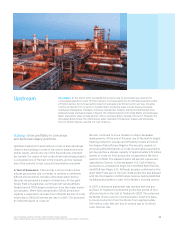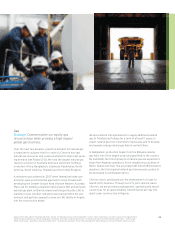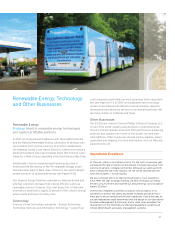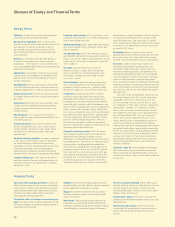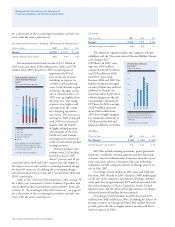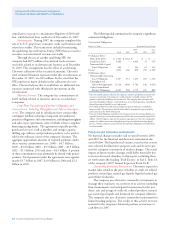Chevron 2007 Annual Report Download - page 35
Download and view the complete annual report
Please find page 35 of the 2007 Chevron annual report below. You can navigate through the pages in the report by either clicking on the pages listed below, or by using the keyword search tool below to find specific information within the annual report.
33
the crude-oil and product-supply functions and the economic
returns on invested capital. Profitability can also be affected
by the volatility of tanker charter rates for the company’s
shipping operations, which are driven by the industry’s
demand for crude oil and product tankers. Other factors
beyond the company’s control include the general level of
inflation and energy costs to operate the company’s refinery
and distribution network.
The company’s most significant marketing areas are the
West Coast of North America, the U.S. Gulf Coast, Latin
America, Asia, sub-Saharan Africa and the United Kingdom.
Chevron operates or has ownership interests in refineries
in each of these areas except Latin America. For the indus-
try, refined-product margins were generally higher in 2007
than in 2006. For the company, U.S. refined-product mar-
gins during 2007 were negatively affected by planned and
unplanned downtime at its three largest U.S. refineries.
Industry margins in the future may be volatile and
are influenced by changes in the price of crude oil used for
refinery feedstock and by changes in the supply and demand
for crude oil and refined products. The industry supply and
demand balance can be affected by disruptions at refineries
resulting from maintenance programs and unplanned out-
ages, including weather-related disruptions; refined-product
inventory levels; and geopolitical events.
Refer to pages 35 through 36 for additional discussion of
the company’s downstream operations.
Chemicals Earnings in the petrochemicals business are
closely tied to global chemical demand, industry inventory
levels and plant capacity utilization. Feedstock and fuel costs,
which tend to follow crude oil and natural gas price move-
ments, also influence earnings in this segment.
Refer to page 36 for
additional discussion of
chemicals earnings.
Key operating develop-
ments and other events
during 2007 and early 2008
included the following:
Upstream
Angola Discovered crude
oil at the 31 percent-owned
and operated Malange-1
well in offshore Block 14.
Additional drilling and
geologic and engineer-
ing studies are planned
to appraise the discovery.
The company and partners
also made the final invest-
ment decision to construct
a lique fied natural gas
(LNG) plant that will
be owned 36 percent by
Chevron. The plant will be
designed with a capacity to process 1 billion cubic feet of
natural gas per day and produce 5.2 million metric tons a
year of LNG and related gas liquids products.
Australia Received federal and state environmental
approvals for development of the 50 percent-owned and
operated Gorgon LNG project located off the northwest
coast. The approvals represented a significant milestone
toward the development of the company’s natural gas
resources offshore Australia.
Bangladesh Began production at the 98 percent-owned
Bibiyana natural gas field. The field’s total production is
expected to increase to a maximum of 500 million cubic feet
per day by 2010.
China Signed a 30-year production-sharing contract
with China National Petroleum Corporation to assume oper-
atorship and hold a 49 percent interest in the development of
the Chuandongbei natural gas area in central China. Design
input capacity of the proposed gas plants is expected to be
740 million cubic feet of natural gas per day.
Indonesia Began commercial operation of the 110-mega-
watt Darajat III geothermal power plant in Garut, West Java.
The plant increased Darajat’s total capacity to 259 megawatts.
Kazakhstan Initiated production from the first phase of
the Sour Gas Injection and Second Generation Plant expan-
sion projects at the 50 percent-owned Tengiz Field. This
phase increased production capacity by 90,000 barrels of
crude oil per day to approximately 400,000. Full facility
expansion is expected to occur during the second-half 2008,
increasing production capacity to 540,000 barrels per day.
Republic of the Congo Confirmed two crude oil discov-
eries in the offshore Moho-Bilondo permit. Evaluation and
development studies were undertaken to appraise the dis-
coveries, in which Chevron holds a 32 percent nonoperated
working interest.
Thailand Signed an agreement to increase sales of natural
gas from company-operated Blocks 10, 11, 12 and 13 in the
Gulf of Thailand to PTT Public Company Limited. Chevron
has ownership interests ranging from 60 percent to 80 percent
in the blocks, which received 10-year production-period exten-
sions to 2022. The company was also granted the concession
rights for a six-year period to four prospective offshore petro-
leum blocks, three of which it will operate.
Trinidad and Tobago Signed an agreement to sell natural
gas to the National Gas Company of Trinidad and Tobago
for 11 years with an option for a four-year extension. The gas
is expected to be sourced from Chevron’s 50 percent-owned
East Coast Marine Area.
United States Announced that first production from the
Tahiti project in the deepwater Gulf of Mexico is expected by
the third quarter 2009. The startup is approximately one year
later than originally planned due to metallurgical problems
with the mooring shackles for the floating production facility.
Downstream
Benelux Countries Sold the company’s 31 percent interest in the
Nerefco Refinery and related assets in the Netherlands, and the
company’s fuels marketing businesses in Belgium, Luxembourg
and the Netherlands, resulting in gains totaling $960 million.
'%'
()%'
-%'
0%'
*%'
Net Proved Reserves
14A – Net Proved Reserves
front – v3
'+'* ', '- '.
.%0
)%0


